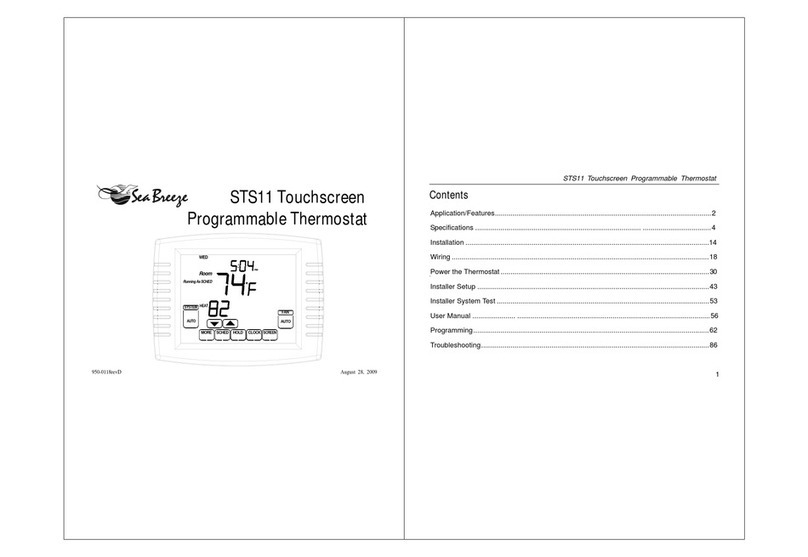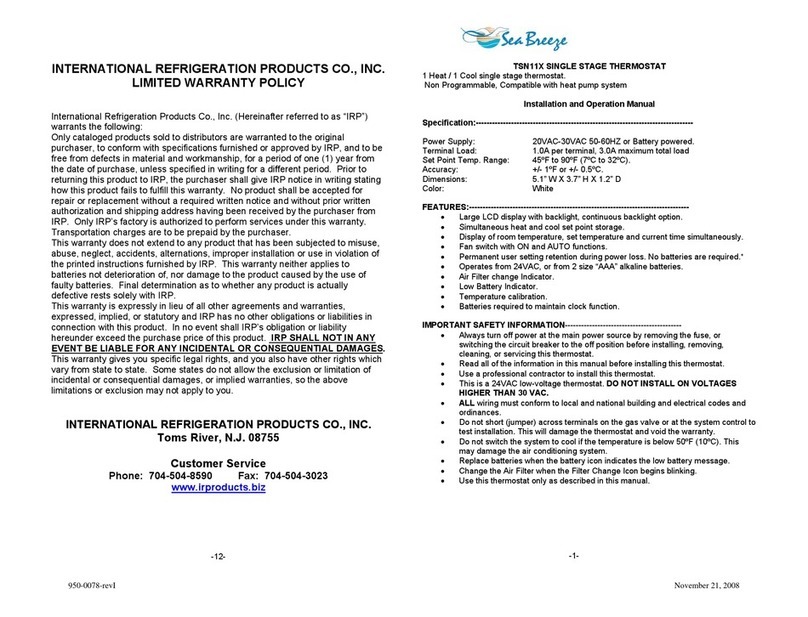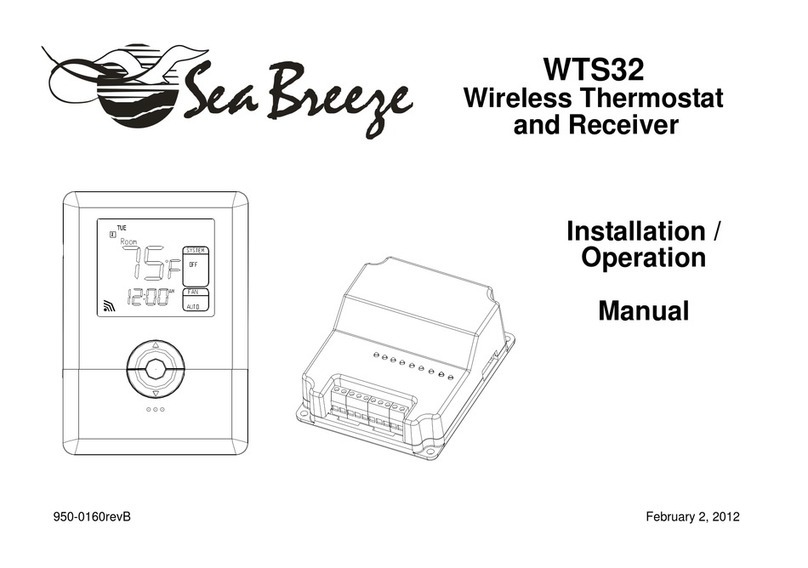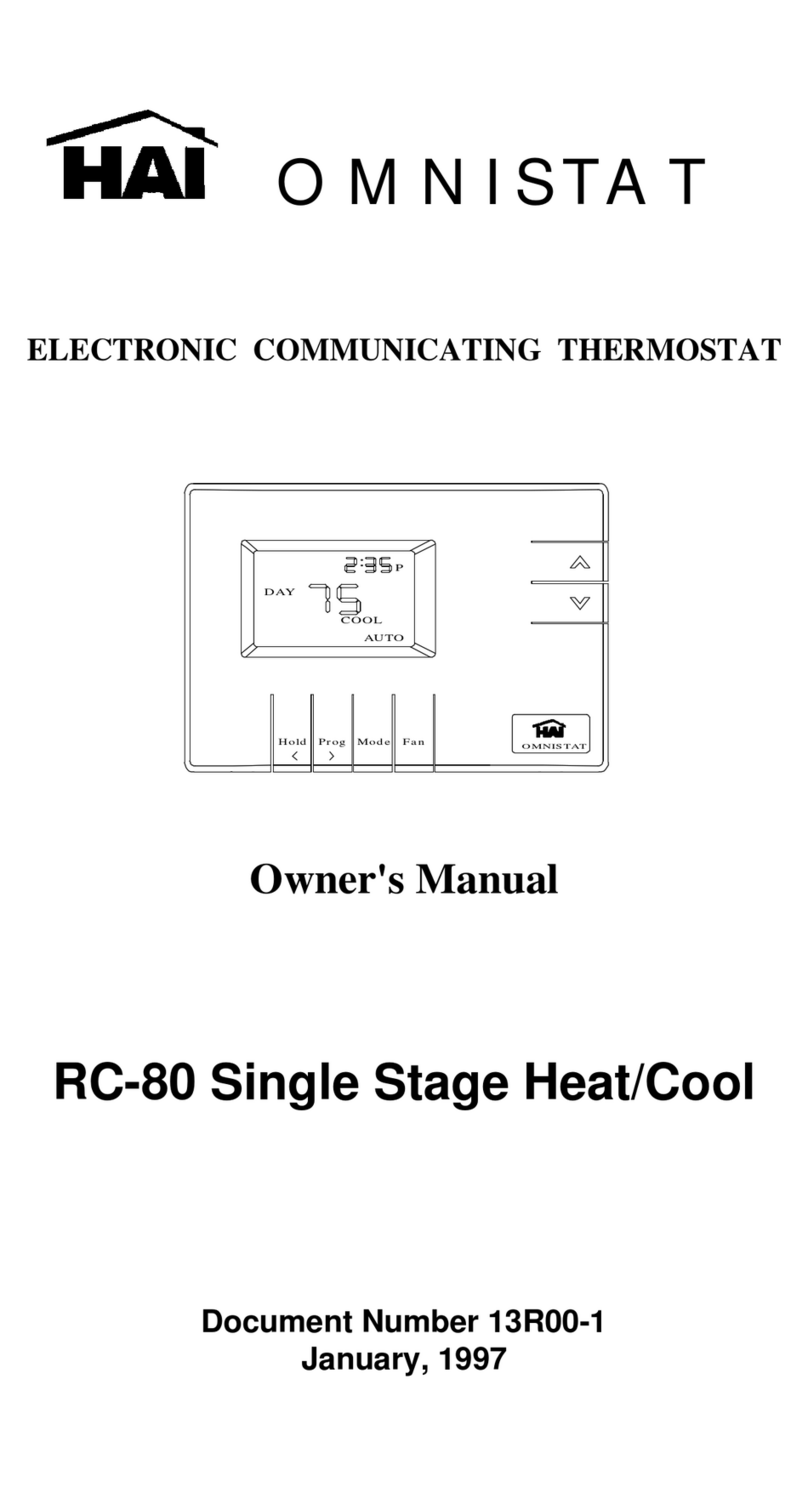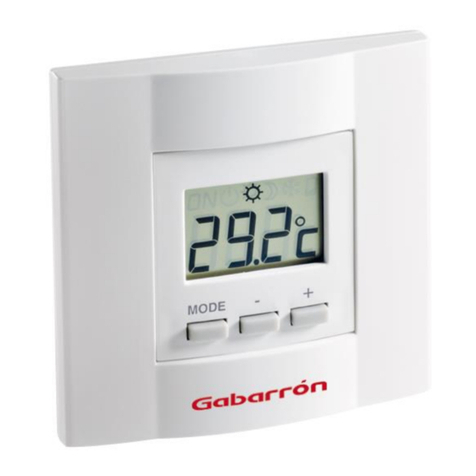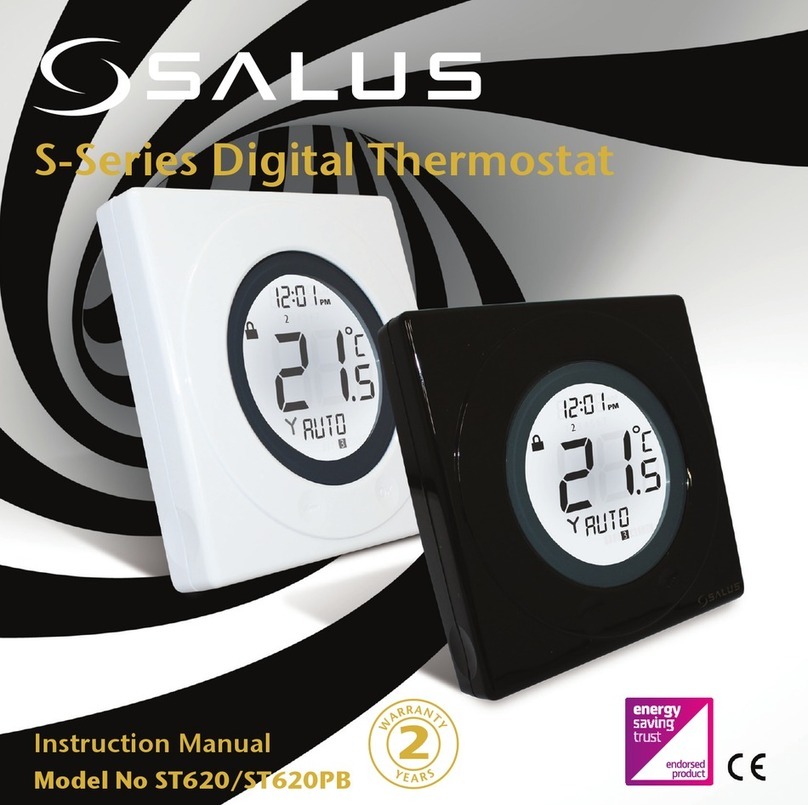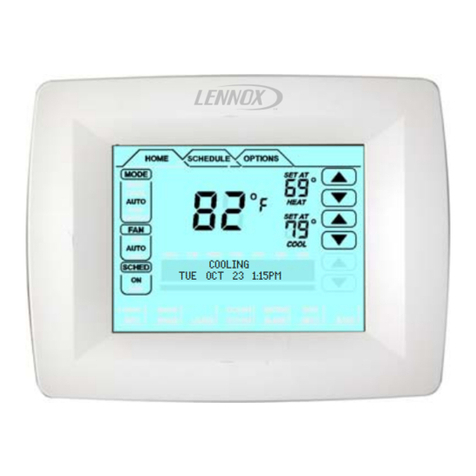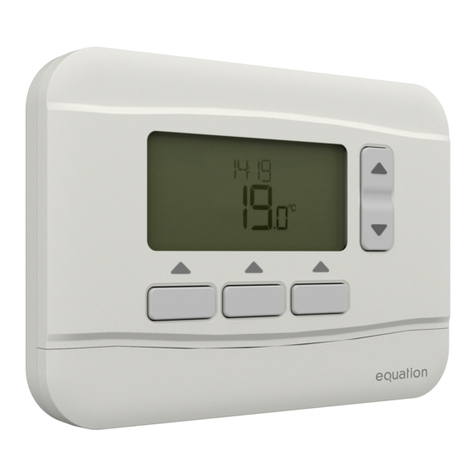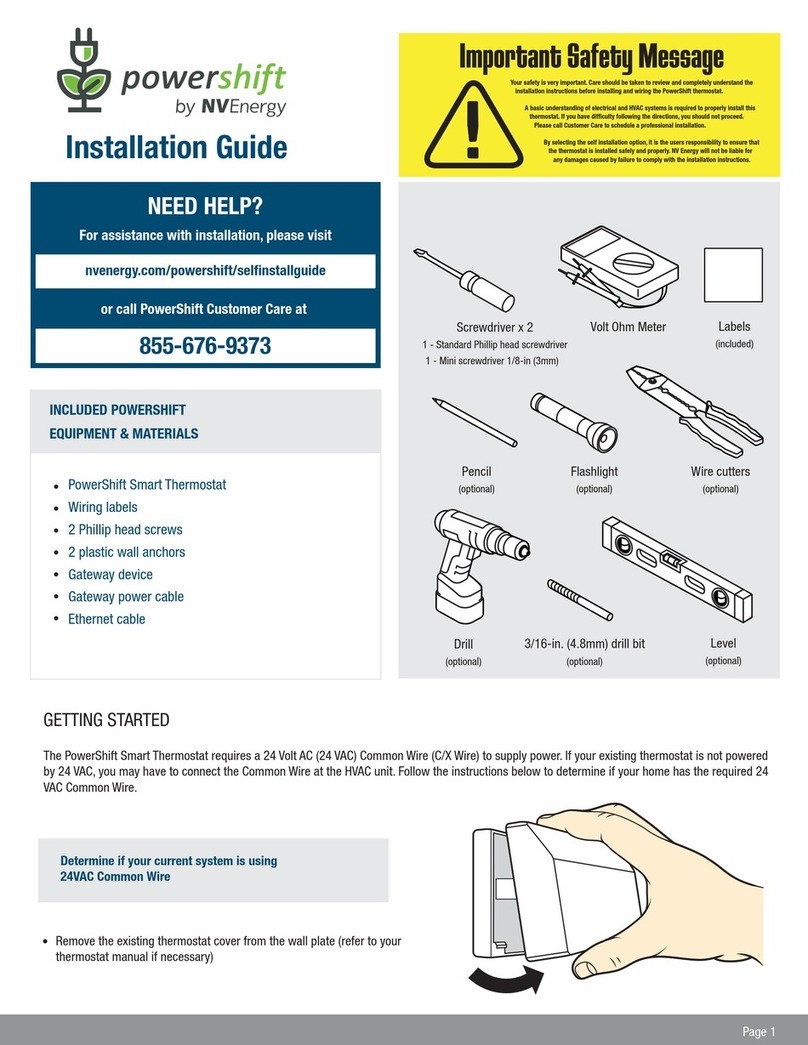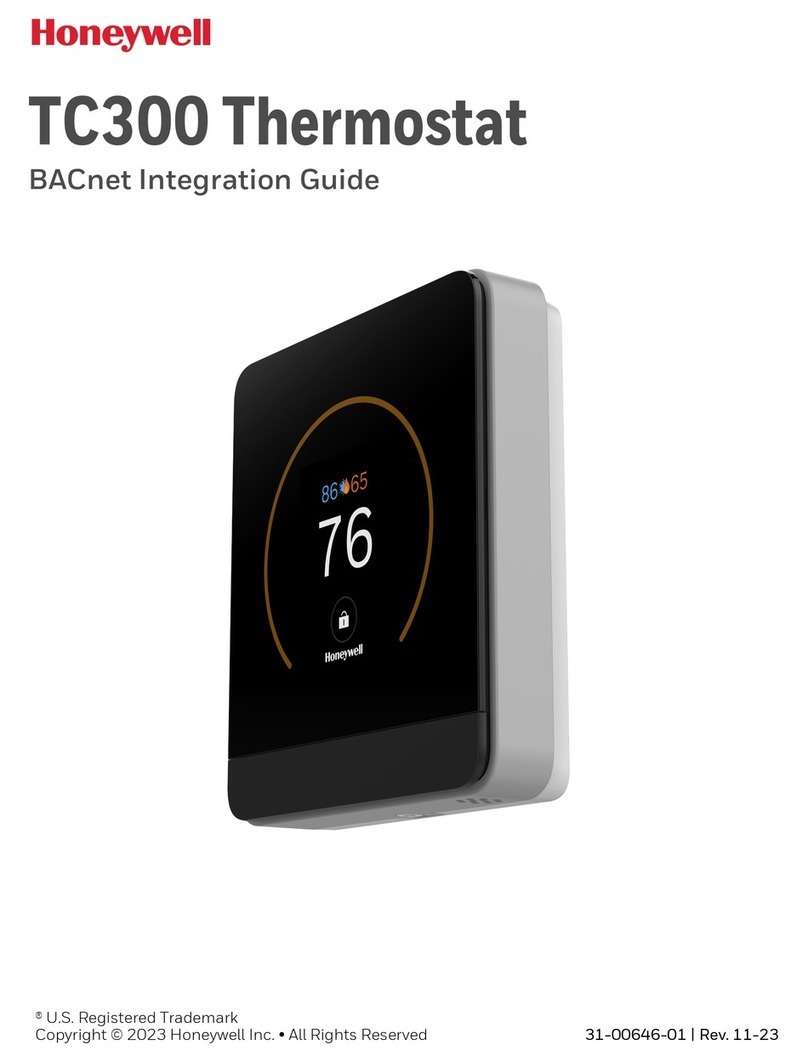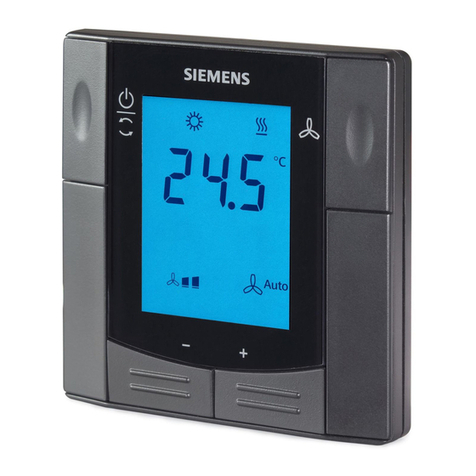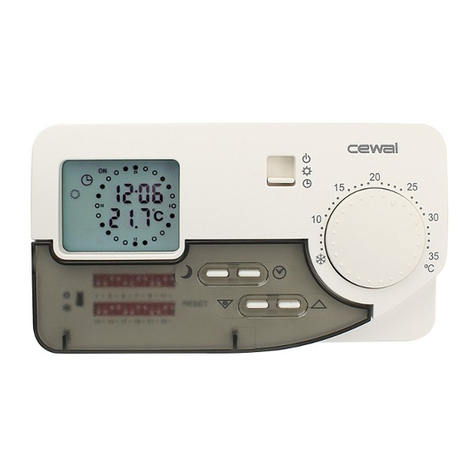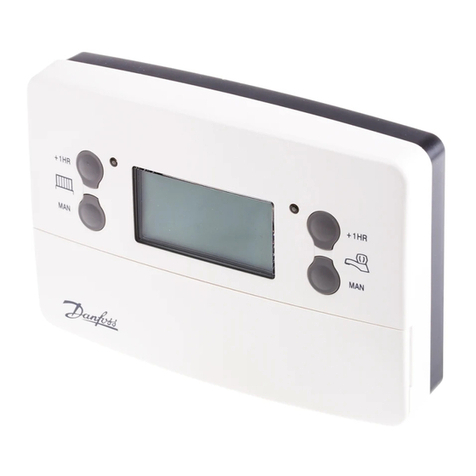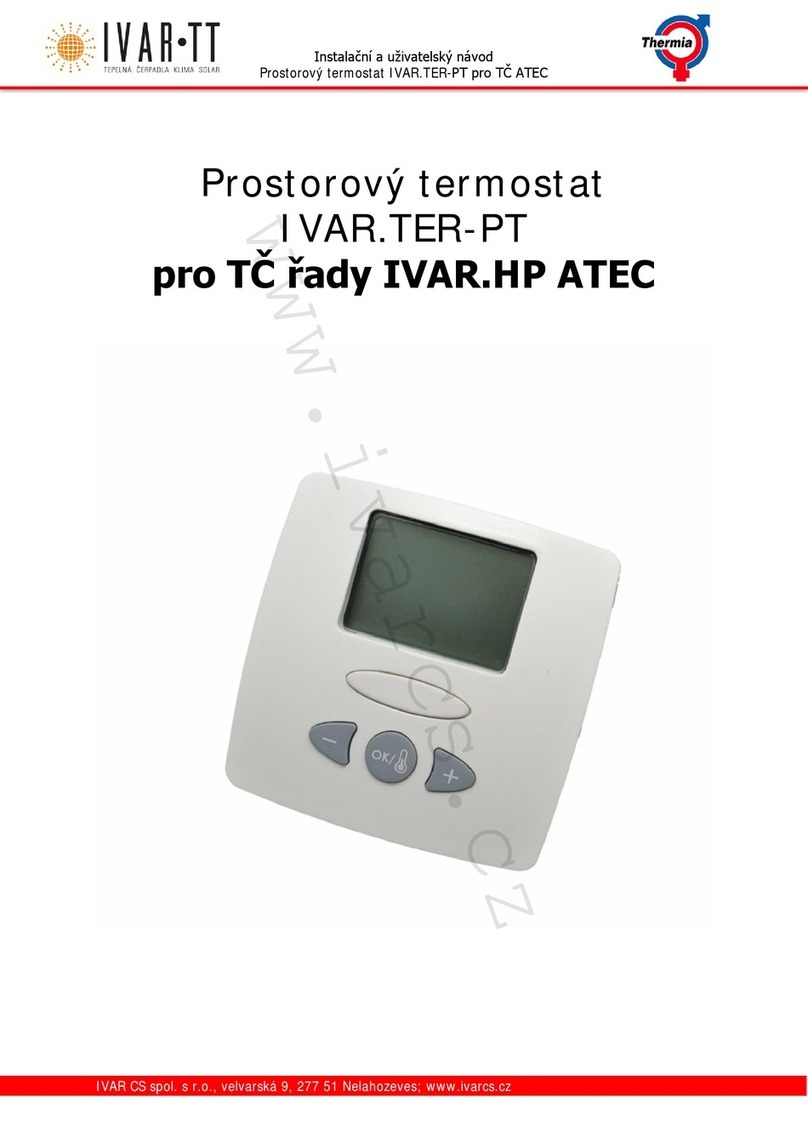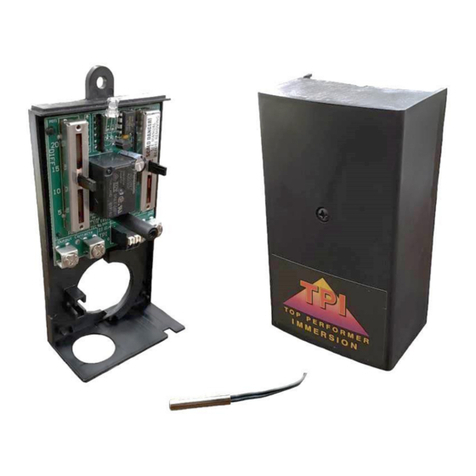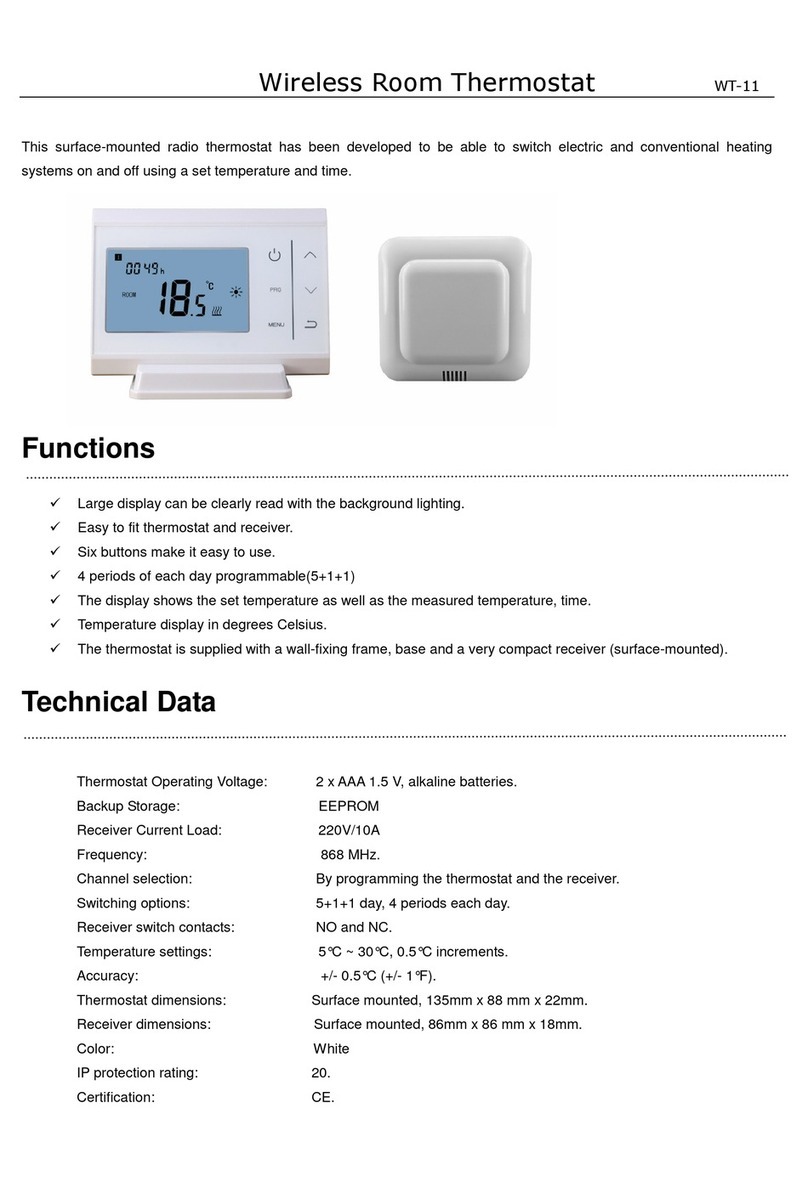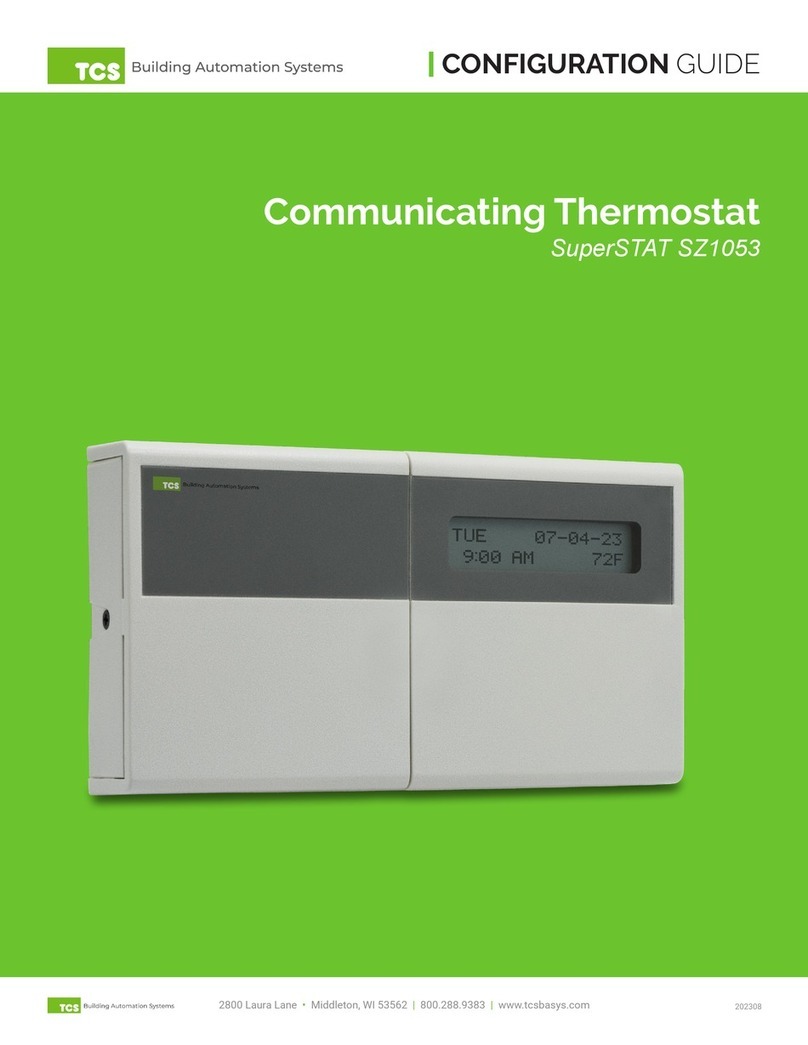Seabreeze SN12I User manual

950-0252revA March 3, 2016
SN12I HEAT PUMP
NON-PROGRAMMABLE THERMOSTAT
Installation and Operation Manual
Specifications
1
Features
1
Important Safety Information
1
Remove the Old Thermostat
3
Install the New Thermostat
4
Configuration
5
Configuration Menu Chart
6
Parameters
6
System Check
8
Basic Thermostat Operation
9
Troubleshooting
10
Warranty
11
International Refrigeration Products, Inc.
1035 Wheeler Way, Langhorne, PA 19047
Service Hours: M –F, 8:00 AM to 4:30 PM
Tel: 215-750-9876

- 1 -
SN12I HEAT PUMP NON-PROGRAMMABLE THERMOSTAT
Installation and Operation Manual
SPECIFICATIONS
Power Supply: 20VAC-30VAC 50-60HZ
Terminal Load: 1.0A per terminal, 3.0A maximum total load
Setpoint Temp. Range: 45ºF to 90ºF (7ºC to 32ºC)
Accuracy: +/- 1ºF or +/- 0.5ºC
Dimensions: 6.0” W X 4.7” H X 1.1” D
Color: White
FEATURES
•Large LCD display with backlight, continuous backlight option
•Independent heat and cool setpoints
•Simultaneous display of room temperature, setpoint, and current time
•Fan switch with ON and AUTO functions
•Permanent user setting retention during power loss - no batteries are required*
•Operates on 24VAC
•Air filter service indicator
•Low battery indicator
•Temperature calibration
•Configurable compressor short cycling protection
•Compatible with 2 heat/1 cool heat pump systems with emergency heat
*Two “AA” batteries required to maintain clock function.
IMPORTANT SAFETY INFORMATION
•Use a professional contractor to install this thermostat.
•Read all of the information in this manual before installing this thermostat.
•WARNING! Electrical Shock Hazard. Always turn off power at the main power source by
removing the fuse or switching the circuit breaker to the “OFF” position before installing,
removing, cleaning, or servicing this thermostat.
•WARNING! Do not install on voltages higher than 30 VAC. This is a 24VAC
low-voltage thermostat.
•All wiring must conform to local and national building and electrical codes and ordinances.
•Do not short (jumper) across terminals on the gas valve or at the system control to test
installation. This will damage the thermostat and void the warranty.
•Do not run the system in cooling if the outside temperature is below 50ºF (10ºC). This may
damage the air conditioning system.
•Replace batteries when the low battery icon flashes.
•Clean or replace the air filter when “SERVICE FILTER” begins flashing.
•Use this thermostat only as described in this manual.

- 2 -
IRP International
Refrigeration Products
THERMOSTAT LIQUID CRYSTAL DISPLAY (LCD)
HEAT OFF COOL
SYSTEM
ROOM
Heating Icon
Room
Temperature
Fan
ON/AUTO
System Mode
EMH/HEAT/OFF/COOL
Cooling Icon
Setpoint
Filter Service ReminderTime & Day Setting
LowBattery Icon
Configuration
Compressor
Lockout Delay
SET TO:
AM
MON
SERVICE FILTER
CONFIG
COMP DELAY
ON
AUTO
AUX
EMH
Figure 1
THERMOSTAT BUTTONS AND SWITCHES
Figure 2
Up/Down Buttons
- Raises or lowers the
temperature setting
- Also used in
configuration, setting
time and day, and
displaying time to next
filter service.
System Switch
(EMH/HEAT/OFF/COOL)
Fan Switch
(ON/AUTO)
Reset Button

- 3 -
REMOVE THE OLD THERMOSTAT
WARNING! Electrical Shock Hazard
1. Turn off power to the thermostat at the main service panel by removing the fuse or switching
the appropriate circuit breaker to the “OFF” position before removing the existing
thermostat.
2. Turn off power to the heating and cooling system by removing the fuse or switching the
appropriate circuit breaker to the “OFF” position.
3. Remove the cover of the old thermostat. This should expose the wires.
4. Label the wires from the existing thermostat using the enclosed wire markers and record in
the chart below before removing.
Thermostat
Terminals
Cable Wire Color
C
L
Y
AUX
E
O
B
G
R
5. Remove the wires from the wire terminals.
6. Remove the existing thermostat from the wall.
THERMOSTAT MOUNTING
Figure 3
A. Push button on the bottom of the
thermostat and gently pull front cover
straight off the base.
B. Use the mounting screws provided to mount the
thermostat base to the wall or junction box.

- 4 -
INSTALL THE NEW THERMOSTAT
WARNING! Electrical Shock Hazard
Ensure that power is turned off. See steps 1 and 2 in previous section.
1. Place the SYSTEM switch in the OFF position. (See Figure 2)
2. Place the FAN switch in the AUTO position. (See Figure 2)
3. Push the button on the bottom of the thermostat and gently pull the front cover straight off
the base. (See Figure 3A)
4. Using thermostat base, identify the placement of the thermostat on the wall or junction box.
Ensure that the base is oriented so that the button latch (from step 3) is at the bottom, and
feed the wires through the wire opening in the base.
5. Using the mounting screws (and anchors) provided, mount the thermostat base loosely to
the wall or junction box. (See Figure 3B)
6. Place a level against the bottom of the base and adjust until level, then tighten the screws.
(Leveling is for appearance only and will not affect thermostat operation.)
7. Insert stripped, labeled wires into matching wire terminals. (See Figure 4 below)
CAUTION: Be sure exposed portions of wires do not touch other wires.
WIRING DIAGRAMS
Notes:
* Auxiliary and emergency heat operate from a single relay, and the “AUX” and “E” terminals may
be jumpered as necessary.
‡Reversing valve activates in cooling when wired to the “O” terminal and activates in heating when
wired to the “B” terminal.
The common must be connected to operate the system. If batteries are installed, they will only
maintain the clock during power outages.
Figure 4

- 5 -
8. Double check that each wire is connected to the proper terminal. Tighten the screws on the
terminal block. Gently tug on each wire to ensure proper connection.
9. Set the FAN OPTION switch on the back of the front cover to the proper position. (See
Figure 5 below) If your system REQUIRES the thermostat to turn on the fan during a call for
emergency heat, such as electric strip heat, place the fan option switch in the ELEC
position. If your system does NOT require the thermostat to energize the fan during a call
for emergency heat, such as a fossil fuel (gas, oil, etc.), forced air, or hydraulic heating
system, place the fan option switch in the GAS position. If you are unsure of your
application, contact a qualified HVAC contractor.
FAN OPTION SWITCH
Figure 5
10. Carefully align the cover with the base and push the cover straight onto the base to snap it
into place.
11. Optional –battery installation. Batteries may be installed to ensure that clock function and
continuous room temperature display are maintained during a power outage. Slide the
lower portion of the thermostat cover (door) downward to expose the battery compartment.
Install two fresh “AA” alkaline batteries in the battery compartment.
CAUTION: Installing batteries backwards can damage the thermostat.
Be sure to match positive (+) and negative (-) ends of the batteries with the proper terminals
in the battery compartment. Note: if the low battery icon is flashing, it indicates that the
batteries need to be replaced.
12. Slide the door upward and click into place.
13. Turn on power at the main service panel.
14. Configure the thermostat and perform system check as described in the following sections.
CONFIGURATION
The configuration menu allows you to set the thermostat parameters.
1. Slide the door downward to reveal the switches.
2. Move the SYSTEM switch to the OFF position and press and hold the ▲ and ▼ buttons at
the same time to enter the configuration menu. The display will show the first parameter in
the configuration menu (CC –cooling cycle rate) and “CONFIG”.
3. Press the ▲ button to scroll through available parameter values. Stop at the desired value.
4. Press the ▼ button to move to the next parameter.
5. Repeat steps 3 and 4 to continue through all parameters. (See “Configuration Menu Chart”)
6. Move the SYSTEM switch to the EMH, HEAT, or COOL position to exit the configuration
menu and return to normal operation. If no buttons are pressed within two minutes, the

- 6 -
thermostat will automatically exit to the OFF mode. Note: All changes made in the
configuration menu are automatically saved.
CONFIGURATION MENU CHART
See “Parameters” section for a detailed explanation of parameters and values.
PARAMETERS
CC - Select Cooling Cycle Rate
The FA setting produces shorter cooling cycles. The SL setting produces longer cooling
cycles. FA cycles the system at a 0.75ºF differential (0.5°C), and SL cycles the system at a
1.5ºF differential (1°C).
HC - Select Heating Cycle Rate
The FA setting produces shorter heating cycles. The SL setting produces longer heating
cycles. FA cycles the system at a 0.75ºF differential (0.5°C), and SL cycles the system at a
1.5ºF differential (1°C).
CP - Select Compressor Lockout Delay
To protect the compressor from short cycling, you can select the minimum length of time the
compressor will turn off between cycles from 0 to 5 minutes in 1 minute increments. When a
compressor lockout delay occurs, “COMP DELAY” will flash.
Parameter
Parameter
Value
Options
Description
Factory
Defaults
CC
FA or SL
Select cooling cycle rate:
FA= fast SL = slow
FA
HC
FA or SL
Select heating cycle rate:
FA= fast SL = slow
FA
CP
0 to 5
Select compressor lockout delay:
0 = none, 1 to 5 = number of minutes delayed after last call
5
AU
1 to 10
Select auxiliary heat offset:
1to 10 = number of degrees below setpoint
4
bL
1, 2, or 3
Select LCD backlight duration:
(1) = OFF (2) = 30 seconds after any button push (3) = always ON
2
FL
00, 1 to 12
Select filter service time:
00 = deactivated 1 to 12 = number of months (1 month = 30 days)
00
FC
F or C
Select temperature scale:
F = °Fahrenheit C = °Celsius
F
CL
-4 to 4
Select temperature calibration value:
-4 to 4 = number of degrees above or below room temperature
0

- 7 -
AU - Select Auxiliary Heat Offset
This feature allows you to select when the auxiliary heat system will turn on. This offset can
be set from 1 to 10 (degrees), in 1°increments, and the auxiliary system will turn on (in
addition to first stage of heat) when the room temperature is below the setpoint by the
selected number of degrees plus heating cycle rate value (HC). For example, if 4 is selected
for the auxiliary heat offset and SL is selected as the heating cycle rate, the auxiliary heat will
turn on when the room temperature shows 6°below setpoint:
4°for offset + 1.5°for SL cycle rate = 5.5°(rounded to 6°on thermostat display)
bL - Select LCD Backlight Duration
The LCD backlight improves display contrast in low lighting conditions. Select 1 for no
backlight. Select 2 for the backlight to come on for approximately 30 seconds when any
button on the thermostat is pressed. Select 3 for the backlight to remain on continuously.
FL - Select Filter Service Time
The thermostat will display “SERVICE FILTER” after a set time of operation. This is a
reminder to clean or replace your air filter. This time can be set from 1 to 12 months in 1
month increments. Note: 1 month = 30 days, and the number of days is also displayed in the
upper left corner of the LCD. A selection of 00 will deactivate this feature. When “SERVICE
FILTER” is displayed, in EMH, HEAT or COOL mode it can be cleared by pressing the ▲
and ▼ buttons at the same time. This resets the timer and starts counting down the days
until the next filter service.
FC - Select ºF or ºC Temperature Scale
Selects the temperature scale to be displayed –(F)ahrenheit or (C)elsius - as desired.
CL - Select Temperature Calibration Value
This feature allows you to adjust the displayed room temperature from 1°to 4ºhigher or
lower than the actual room temperature. Your thermostat can be accurately calibrated to
match your previous thermostat. The temperature displayed will reflect the adjusted
temperature. Select 0 if no calibration is desired.
Setting the Time and Day
1. Move the SYSTEM switch to the OFF position, then press and hold the ▼button for 3
seconds to enter the time/day setting mode. The display will flash the hour first.
2. Press the ▲button to set the desired value.
3. Press the ▼button to move to the next item (minutes and day of the week).
4. Repeat steps 2 and 3 until time and day are both set.
5. Press the ▼button or move the SYSTEM switch to the EMH, HEAT,or COOL position to
exit the time/day setting mode. If no buttons are pressed within 15 seconds, the thermostat
will automatically exit to the OFF mode.

- 8 -
SYSTEM CHECK
If at any time during testing your system does not operate properly, contact a qualified HVAC
contractor.
Ensure that there is power to the system.
Fan Operation
(If your system does not have a “G” (Fan) terminal connection, skip to the “Heating System”
section.)
1. Move the SYSTEM switch to the OFF position.
2. Move the FAN switch to the ON position. The blower should begin to operate.
3. Move the FAN switch to the AUTO position. The blower should stop immediately.
Heating System
1. Move the SYSTEM switch to the HEAT position. If the auxiliary heating system has a
standing pilot, be sure to light it.
2. Adjust the setpoint to a temperature above the current room temperature.
If the (FA)st heating cycle rate is selected in the configuration menu (see “Configuration
Menu Chart”), the thermostat will call for heat when the room temperature is 0.75ºF (0.5ºC)
below setpoint and turn off at setpoint.
If the (SL)ow heating cycle rate is selected, the thermostat will call for heat when the room
temperature is 1.5ºF (1ºC) below setpoint and turn off at setpoint.
The auxiliary heat will activate when the room temperature is below the setpoint by the
auxiliary heat offset value (AU) plus heating cycle rate value (HC), as established during
configuration. When auxiliary heat turns on “AUX” will be displayed. (See “Configuration
Menu Chart”, “Parameters”, and Figure 1.)
* Note: Auxiliary heat will only activate in conjunction with the compressor and fan and
therefore will be affected by compressor lockout delay settings. (See “Configuration
Menu Chart”) Once activated, auxiliary heat will continue to run until the room
temperature is less than 2°F (1°C) below setpoint, and the first stage of heat will
complete the call.
3. When the thermostat calls for heat, will display. If is not displayed and “COMP
DELAY” is flashing, the compressor lockout delay feature is operating in the heat pump
mode. (See “Configuration Menu Chart”)
Emergency Heating System
The Emergency Heat System bypasses the heat pump to use the heat source connected to
terminal “E” on the thermostat. It is typically used when compressor operation is not desired or
you prefer to use the backup heating system only.
1. Move the SYSTEM switch to the EMH position. “EMH” will flash on the display as long as

- 9 -
the switch stays in this position.
2. Adjust the setpoint to a temperature above the current room temperature.
If the (FA)st heating cycle rate is selected in the configuration menu (see “Configuration
Menu Chart”), the thermostat will call for emergency heat when the room temperature is
0.75ºF (0.5ºC) below setpoint and turn off at setpoint.
If the (SL)ow heating cycle rate is selected, the thermostat will call for emergency heat
when the room temperature is 1.5ºF (1ºC) below setpoint and turn off at setpoint.
3. In emergency heat mode, “AUX” will display when the thermostat is in a call for heat.
Note –will not display.
Cooling System
CAUTION: To prevent compressor and/or property damage, if the outdoor temperature
is below 50ºF (10ºC), DO NOT operate the cooling system.
1. Move the SYSTEM switch to the COOL position.
2. Adjust the setpoint to a temperature below the current room temperature.
If the (FA)st cooling cycle rate is selected in the configuration menu (see “Configuration
Menu Chart”), the thermostat will call for cooling when the room temperature is 0.75ºF
(0.5ºC) above setpoint and turn off at setpoint.
If the (SL)ow cooling cycle rate is selected, the thermostat will call for cooling when the
room temperature is 1.5ºF (1ºC) above setpoint and turn off at setpoint.
3. When the thermostat calls for cooling, will display. If is not displayed and “COMP
DELAY” is flashing, the compressor lockout delay feature is operating. (See “Configuration
Menu Chart”)
Equipment Monitor
The “L” terminal on the thermostat allows for an equipment monitor input. For example, a
compressor drip pan overflow alarm could be wired. When a 24 VAC signal is sent to the “L”
terminal, the thermostat will flash “SERVICE” on the LCD to indicate that action is required.
Contact your HVAC contractor for details on what may be wired to the “L” terminal.
If all functions listed above operate properly, the thermostat is installed correctly.
BASIC THERMOSTAT OPERATION
Setting the Thermostat
1. This thermostat is very easy to operate. Move the SYSTEM switch to either EMH, HEAT, or
COOL, then press either the ▲ or ▼ button to adjust the setpoint to the desired value.
2. Move the FAN switch to either AUTO or ON. AUTO will run the fan only when the
thermostat calls for heating, emergency heating (depending on the position of the FAN
OPTION switch –see page 5), or cooling. ON will run the fan continuously. Note –
continuous fan will run in EMH, HEAT, COOL, and OFF system settings.

- 10 -
3. To turn the system off, move the SYSTEM switch to the OFF position and the FAN switch to
the AUTO position.
Filter Review
1. Move the SYSTEM switch to the EMH, HEAT, or COOL position, then press and hold the ▲
and ▼buttons at the same time for 5 seconds to enter the filter review mode. (Note –When
“SERVICE FILTER” message is displayed and after filter has been cleaned or replaced, this
same process is used to clear “SERVICE FILTER” message.)
2. The number of days left until filter cleaning or replacement will be displayed.
3. Press either the ▲or ▼button one time to exit the filter review mode. If no buttons are
pressed within 15 seconds, the thermostat will exit to normal operation.
4. In filter review mode, press and hold the ▲and ▼buttons at the same time to reset the
amount of time until the next filter service. The display will flash “dEF”to indicate that reset
has been completed, unless FL has been deactivated, selection 00. (See “Configuration
Menu Chart”)
TROUBLESHOOTING
If a voltage spike or static discharge blanks out the display or causes erratic thermostat
operation:
1. You can reset the thermostat by pressing the reset button. (See Figure 2)
2. Remove power (and batteries, if installed) until display goes blank. Then restore power (and
reinstall batteries).
3. If the thermostat has power, has been reset, and still does not function correctly, contact a
qualified HVAC contractor.

- 11 -
INTERNATIONAL REFRIGERATION PRODUCTS CO., INC.
LIMITED WARRANTY POLICY
International Refrigeration Products Co., Inc. (Hereinafter referred to as
“IRP”) warrants the following:
Only cataloged products sold to distributors are warranted to the original
purchaser, to conform with specifications furnished or approved by IRP, and
to be free from defects in material and workmanship, for a period of one (1)
year from the date of purchase, unless specified in writing for a different
period. Prior to returning this product to IRP, the purchaser shall give IRP
notice in writing stating how this product fails to fulfill this warranty. No
product shall be accepted for repair or replacement without a required
written notice and without prior written authorization and shipping address
having been received by the purchaser from IRP. Only IRP's factory is
authorized to perform services under this warranty. Transportation charges
are to be prepaid by the purchaser.
This warranty does not extend to any product that has been subjected to
misuse, abuse, neglect, accidents, alternations, improper installation or use
in violation of the printed instructions furnished by IRP. This warranty neither
applies to batteries not deterioration of, nor damage to the product caused by
the use of faulty batteries. Final determination as to whether any product is
actually defective rests solely with IRP.
This warranty is expressly in lieu of all other agreements and warranties,
expressed, implied, or statutory and IRP has no other obligations or liabilities
in connection with this product. In no event shall IRP's obligation or liability
hereunder exceed the purchase price of this product.
IRP SHALL NOT INANY EVENT BE LIABLE FORANY INCIDENTAL OR
CONSEQUENTIAL DAMAGES.
This warranty gives you specific legal rights, and you also have other rights
which vary from state to state. Some states do not allow the exclusion or
limitation of incidental or consequential damages, or implied warranties, so
the above limitations or exclusion may not apply to you.
INTERNAT IONAL REFRIGERATION PRODUCTS CO ., INC.
LI MIT ED WARRANTY POL ICY
INTERNAT IONAL REFRIGERATION PRODUCTS CO ., INC.
Langh orne, PA 19047
www.irproducts.biz
INTERNATIONAL REFRIGERATION PRODUCTS CO., INC.
Langhorne, PA 19047
www.irproducts.biz
International Refrigeration Products Co., Inc. (Hereinafter referred to as IRP”)
warrants the following:
Only cataloged products sold to distributors are warranted to the original
purchaser, to conform with specifications furnished or approved by IRP, and
to be free from defects in material and workmanship, for a period of one (1)
year from the date of purchase, unless specified in writing for a different
period. Prior to returning this product to IRP, the purchaser shall give IRP
notice in writing stating how this product fails to fulfill this warranty. No
product shall be accepted for repair or replacement without a required
written notice and without prior written authorization and shipping address
having been received by the purchaser from IRP. Only IRP's factory is
authorized to perform services under this warranty. Transportation charges
are to be prepaid by the purchaser.
This warranty does not extend to any product that has been subjected to
misuse, abuse, neglect, accidents, alternations, improper installation or use
in violation of the printed instructions furnished by IRP. This warranty neither
applies to batteries not deterioration of, nor damage to the product caused by
the use of faulty batteries. Final determination as to whether any product is
actually defective rests solely with IRP.
This warranty is expressly in lieu of all other agreements and warranties,
expressed, implied, or statutory and IRP has no other obligations or liabilities
in connection with this product. In no event shall IRP's obligation or liability
hereunder exceed the purchase price of this product.
IRP SHALL NOT IN ANY EVENT BE LIABLE FOR ANY INCIDENTAL OR
CONSEQUENTIAL DAMAGES.
This warranty gives you specific legal rights, and you also have other rights
which vary from state to state. Some states do not allow the exclusion or
limitation of incidental or consequential damages, or implied warranties, so
the above limitations or exclusion may not apply to you.
Table of contents
Other Seabreeze Thermostat manuals

